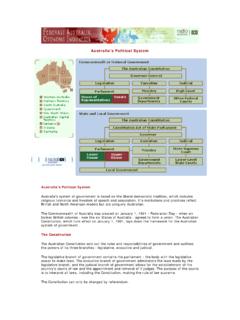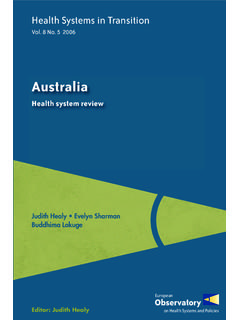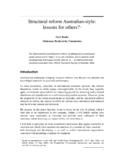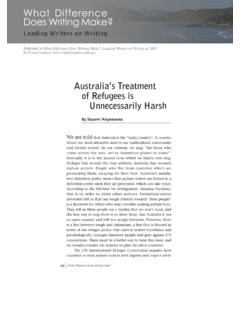Transcription of Agricultural Water Pricing: Australia - OECD.org
1 Agricultural Water pricing : Australia 2 ORGANISATION FOR ECONOMIC CO-OPERATION AND DEVELOPMENT The OECD is a unique forum where the governments of 30 democracies work together to address the economic, social and environmental challenges of globalisation. The OECD is also at the forefront of efforts to understand and to help governments respond to new developments and concerns, such as corporate governance, the information economy and the challenges of an ageing population. The Organisation provides a setting where governments can compare policy experiences, seek answers to common problems, identify good practice and work to co-ordinate domestic and international policies. The OECD member countries are: Australia , Austria, Belgium, Canada, the Czech Republic, Denmark, Finland, France, Germany, Greece, Hungary, Iceland, Ireland, Italy, Japan, Korea, Luxembourg, Mexico, the Netherlands, New Zealand, Norway, Poland, Portugal, the Slovak Republic, Spain, Sweden, Switzerland, Turkey, the United Kingdom and the United States.
2 The Commission of the European Communities takes part in the work of the OECD. OECD 2010 Agricultural Water pricing : Australia SEAMUS PARKER COUNCIL OF MAYORS (SOUTH-EAST QUEENSLAND) ROBERT SPEED FREELANCE CONSULTANT Australia 4 Note This document, Agricultural Water pricing : Australia , by Seamus Parker, Council of Mayors (South-East Queensland) and Robert Speed, Freelance Consultant, Brisbane, Australia , is one of the background reports supporting the OECD study (2010) Sustainable Management of Water Resources in Agriculture, which is available at The report was carried out under the auspices of the OECD Joint Working Party on Agriculture and the Environment of the Committee for Agriculture and the Environment Policy Committee. The report is published under the responsibility of the author and does not necessarily reflect the views of the OECD or its member countries.
3 The other background reports (also available at ) are: An Economic Analysis of the Virtual Water Concept in Relation to the Agri-food Sector Dennis Wichelns, Hanover College, United States Agriculture s Role in Flood Adaptation and Mitigation Policy Issues and Approaches Joe Morris, Tim Hess and Helena Posthumus, Cranfield University, United Kingdom Environmental Effectiveness and Economic Efficiency of Water Use in Agriculture: The Experience of and Lessons from the Australian Water Reform Programme Michael D. Young, University of Adelaide, Australia Financing Water Management and Infrastructure Related to Agriculture across OECD Countries Frank A. Ward, New Mexico State University, United States Agricultural Water pricing : EU and Mexico Alberto Garrido, Universidad Polit cnica de Madrid; and Javier Calatrava, Universidad Polit cnica de Cartagena, Spain Agricultural Water pricing in Japan and Korea James E.
4 Nickum and Chisa Ogura, Asian Water and Resources Institute, Japan Agricultural Water pricing in Turkey Erol H. Cakmak, Middle East Technical University, Turkey Agricultural Water pricing : United States Dennis Wichelns, Hanover College, United States 5 Table of Contents Executive Summary .. 6 Introduction .. 6 The nature of Agricultural Water supplies .. 7 Water sector reforms in Australia .. 7 Irrigation Water pricing in Queensland .. 11 Irrigation Water pricing in Victoria .. 13 Irrigation Water pricing in New South Wales .. 16 Main policy conclusions .. 18 Annexes .. 20 Bibliography .. 27 6 Executive Summary In the early 1990s, governments in Australia and the irrigated agriculture sector were confronted with a number of fundamental challenges. Prices being paid by farmers for irrigation Water delivery were generally not covering the costs of supply, the government owned irrigation infrastructure was not being managed in a commercial manner, Water entitlements were poorly defined, and the health of rivers and aquifers in many parts of the country was deteriorating.
5 Within the Australian federal system, the State governments have constitutional responsibilities for Water management, and own much of the irrigation infrastructure. However, the scale and significance of the issues necessitated a national approach, and in 1994 the Council of Australian Governments (COAG), comprising the Prime Minister and leaders of the States and Territories agreed on a response. Importantly, the Water resources policy was seen as part of a broader micro-economic reform agenda that included reforms to such diverse areas as road transport and regulation of occupations. Water pricing was one element of the agenda, another being the institutional separation of service delivery from regulation. State-owned irrigation schemes became commercially focussed either through becoming government owned corporations, or being transferred to users to own and operate.
6 The States committed to lower bound pricing , meaning Water prices covered the operation, maintenance and refurbishment costs of supply but not a commercial return on the assets. Water businesses were established, farmers became customers and Water became a product. The subsidies of years past became explicit, and price paths were developed to remove them. State governments received incentive payments from the Australian Government if policy outcomes were met. A new body, the National Competition Council (NCC), was established and it assessed each State s performance in Water and the other areas of micro-economic reform. States met the new Water pricing policy objectives, though the timeframes for implementation varied depending largely on the extent of the price increases necessary.
7 A small number of schemes which simply were not economically viable continued to receive explicit and transparent community service obligation payments. In 2004, the Water sector reforms were refreshed with the National Water Initiative (NWI) building on progress since 1994. The National Water Commission (NWC) was established as a statutory body to drive the reforms and provide advice to COAG. The NWC assumed responsibility for assessing States performance on pricing reforms, and its 2005 assessment of progress found States had met the lower bound targets (NWC, 2006). While Water pricing is now at lower bound, both irrigation and urban Water pricing reforms continue to be a key element of the NWI, with a focus on developing nationally consistent approaches to matters such as capital recovery and the identification of Water planning and managements costs.
8 Introduction This paper is a study of Agricultural (irrigation) Water pricing in Australia . It examines Agricultural Water price ranges and characteristics, and the extent to which the price paid by irrigators recovers operation, maintenance and capital costs for Water delivery to the farm ( cost of supply). The paper provides a brief overview of Water management arrangements in Australia and outlines the national principles that have been adopted to guide Water pricing (including for Agricultural Water ) across the States. The paper then provides a detailed review of the Water pricing approach in a number of different States. For each State, the institutional arrangements are described (in respect of Water management, Water supply, and price setting responsibilities) as well as the way prices have been determined, the prices themselves, and the extent to which these prices reflect actual cost of supply.
9 For various political, historical and physical reasons, there are significant regional variations (even within States) in prices. Within a State, there can be dozens of Water supply schemes, some with different owners, with different pricing methodologies and tariffs. It can then be difficult to be either categorical or exhaustive in describing how Water prices are set and their level. This paper endeavours to provide an overview of the principles underpinning Agricultural Water pricing in Australia , together with specific examples from some of the key, and representative, regions and Water supply schemes. 7 In assessing the Water prices and the extent to which they recover the costs of supply, privately owned irrigation schemes have not been included. However, the costs of wholesale or bulk Water from government owned assets to these schemes has been assessed.
10 Detailed data is presented for irrigation Water supplied in Queensland, New South Wales and Victoria, which between them account for around 85% of irrigated agriculture by volume of Water supplied (ABS, 2008). In the States of South Australia and Western Australia , the major irrigation schemes and owned and operated by companies owned by the irrigators. As part of the reforms in Australia , Water businesses have been institutionally separated from the regulatory bodies. The irrigation assets (dams, pipes, channels) have been moved from government departments to stand alone businesses with a commercial focus. Agriculture Water prices should cover the costs of those businesses in Australia these prices are referred to as Water storage and delivery charges (NWC 2007a). This separation has meant that planning and managing Water resources is undertaken by government agencies, with the associated costs met by the government, with some recovery through licence fees or other charges paid by Water users.















